RMIT/SIM Ethics and Governance: Critical Reflection Assignment
VerifiedAdded on 2022/08/16
|6
|1209
|13
Report
AI Summary
This report is a critical reflection on ethics and governance, analyzing four articles on ethical decision-making and organizational influences. The reflection begins by defining ethical decision-making as a process of recognizing and resolving challenges in a business context, emphasizing the importance of careful discussion among interested parties and the application of ethical principles. The report then contrasts the perspectives of Gioia (1992), who discusses personal involvement in the Pinto fire case and the cognitive scripts that influenced unethical behavior, with Jones and Ryan (1998), who focus on moral judgment and behavior within organizations. It further examines Monahan and Quinn's (2006) analysis of organizational deviance and Sonenshein's (2007) model of intuitive judgment in ethical decision-making. The report highlights the importance of business ethics, emphasizing that organizations must meet both economic and ethical responsibilities, adhering to principles such as respect, trustworthiness, fairness, responsibility, citizenship, and care.
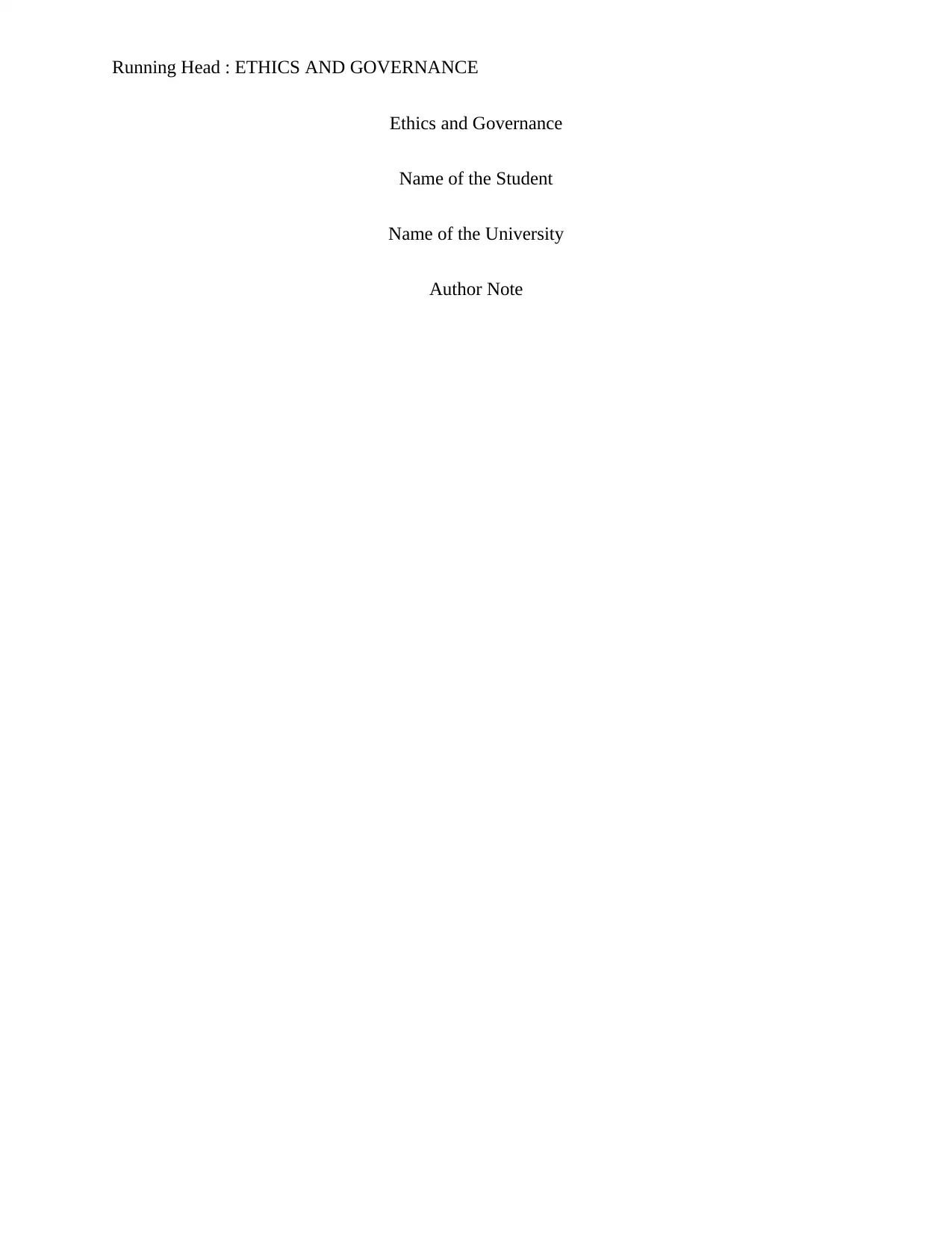
Running Head : ETHICS AND GOVERNANCE
Ethics and Governance
Name of the Student
Name of the University
Author Note
Ethics and Governance
Name of the Student
Name of the University
Author Note
Paraphrase This Document
Need a fresh take? Get an instant paraphrase of this document with our AI Paraphraser
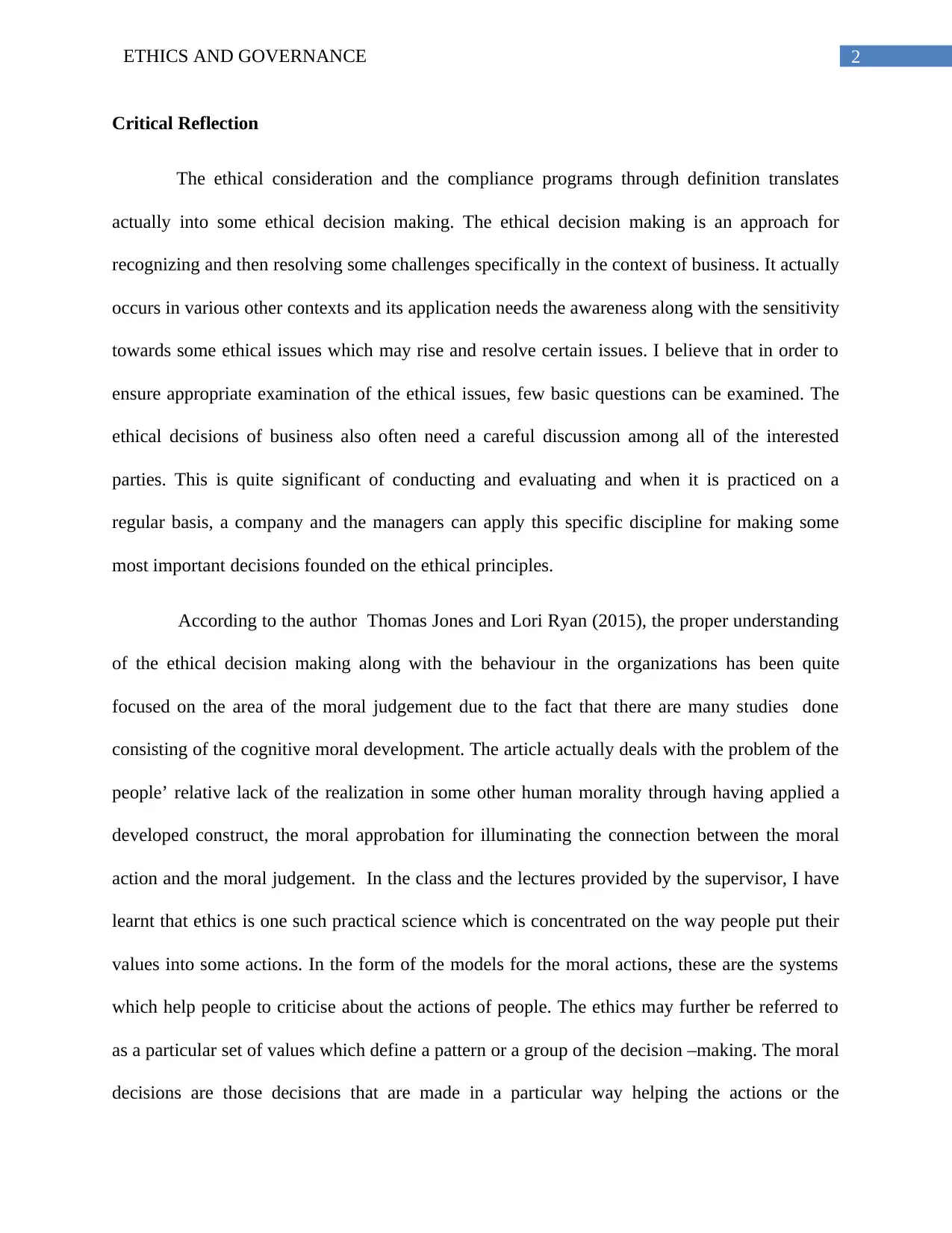
2ETHICS AND GOVERNANCE
Critical Reflection
The ethical consideration and the compliance programs through definition translates
actually into some ethical decision making. The ethical decision making is an approach for
recognizing and then resolving some challenges specifically in the context of business. It actually
occurs in various other contexts and its application needs the awareness along with the sensitivity
towards some ethical issues which may rise and resolve certain issues. I believe that in order to
ensure appropriate examination of the ethical issues, few basic questions can be examined. The
ethical decisions of business also often need a careful discussion among all of the interested
parties. This is quite significant of conducting and evaluating and when it is practiced on a
regular basis, a company and the managers can apply this specific discipline for making some
most important decisions founded on the ethical principles.
According to the author Thomas Jones and Lori Ryan (2015), the proper understanding
of the ethical decision making along with the behaviour in the organizations has been quite
focused on the area of the moral judgement due to the fact that there are many studies done
consisting of the cognitive moral development. The article actually deals with the problem of the
people’ relative lack of the realization in some other human morality through having applied a
developed construct, the moral approbation for illuminating the connection between the moral
action and the moral judgement. In the class and the lectures provided by the supervisor, I have
learnt that ethics is one such practical science which is concentrated on the way people put their
values into some actions. In the form of the models for the moral actions, these are the systems
which help people to criticise about the actions of people. The ethics may further be referred to
as a particular set of values which define a pattern or a group of the decision –making. The moral
decisions are those decisions that are made in a particular way helping the actions or the
Critical Reflection
The ethical consideration and the compliance programs through definition translates
actually into some ethical decision making. The ethical decision making is an approach for
recognizing and then resolving some challenges specifically in the context of business. It actually
occurs in various other contexts and its application needs the awareness along with the sensitivity
towards some ethical issues which may rise and resolve certain issues. I believe that in order to
ensure appropriate examination of the ethical issues, few basic questions can be examined. The
ethical decisions of business also often need a careful discussion among all of the interested
parties. This is quite significant of conducting and evaluating and when it is practiced on a
regular basis, a company and the managers can apply this specific discipline for making some
most important decisions founded on the ethical principles.
According to the author Thomas Jones and Lori Ryan (2015), the proper understanding
of the ethical decision making along with the behaviour in the organizations has been quite
focused on the area of the moral judgement due to the fact that there are many studies done
consisting of the cognitive moral development. The article actually deals with the problem of the
people’ relative lack of the realization in some other human morality through having applied a
developed construct, the moral approbation for illuminating the connection between the moral
action and the moral judgement. In the class and the lectures provided by the supervisor, I have
learnt that ethics is one such practical science which is concentrated on the way people put their
values into some actions. In the form of the models for the moral actions, these are the systems
which help people to criticise about the actions of people. The ethics may further be referred to
as a particular set of values which define a pattern or a group of the decision –making. The moral
decisions are those decisions that are made in a particular way helping the actions or the
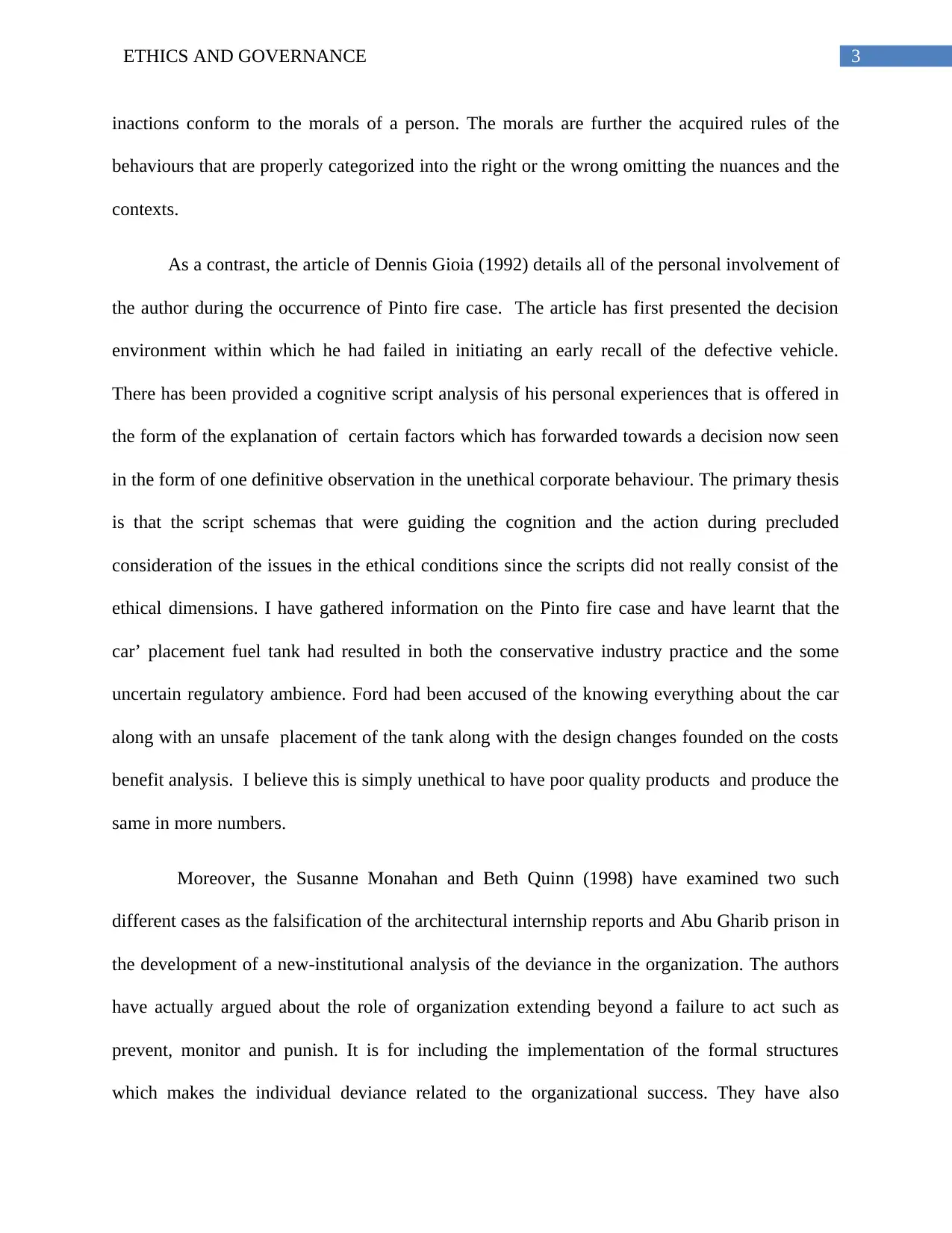
3ETHICS AND GOVERNANCE
inactions conform to the morals of a person. The morals are further the acquired rules of the
behaviours that are properly categorized into the right or the wrong omitting the nuances and the
contexts.
As a contrast, the article of Dennis Gioia (1992) details all of the personal involvement of
the author during the occurrence of Pinto fire case. The article has first presented the decision
environment within which he had failed in initiating an early recall of the defective vehicle.
There has been provided a cognitive script analysis of his personal experiences that is offered in
the form of the explanation of certain factors which has forwarded towards a decision now seen
in the form of one definitive observation in the unethical corporate behaviour. The primary thesis
is that the script schemas that were guiding the cognition and the action during precluded
consideration of the issues in the ethical conditions since the scripts did not really consist of the
ethical dimensions. I have gathered information on the Pinto fire case and have learnt that the
car’ placement fuel tank had resulted in both the conservative industry practice and the some
uncertain regulatory ambience. Ford had been accused of the knowing everything about the car
along with an unsafe placement of the tank along with the design changes founded on the costs
benefit analysis. I believe this is simply unethical to have poor quality products and produce the
same in more numbers.
Moreover, the Susanne Monahan and Beth Quinn (1998) have examined two such
different cases as the falsification of the architectural internship reports and Abu Gharib prison in
the development of a new-institutional analysis of the deviance in the organization. The authors
have actually argued about the role of organization extending beyond a failure to act such as
prevent, monitor and punish. It is for including the implementation of the formal structures
which makes the individual deviance related to the organizational success. They have also
inactions conform to the morals of a person. The morals are further the acquired rules of the
behaviours that are properly categorized into the right or the wrong omitting the nuances and the
contexts.
As a contrast, the article of Dennis Gioia (1992) details all of the personal involvement of
the author during the occurrence of Pinto fire case. The article has first presented the decision
environment within which he had failed in initiating an early recall of the defective vehicle.
There has been provided a cognitive script analysis of his personal experiences that is offered in
the form of the explanation of certain factors which has forwarded towards a decision now seen
in the form of one definitive observation in the unethical corporate behaviour. The primary thesis
is that the script schemas that were guiding the cognition and the action during precluded
consideration of the issues in the ethical conditions since the scripts did not really consist of the
ethical dimensions. I have gathered information on the Pinto fire case and have learnt that the
car’ placement fuel tank had resulted in both the conservative industry practice and the some
uncertain regulatory ambience. Ford had been accused of the knowing everything about the car
along with an unsafe placement of the tank along with the design changes founded on the costs
benefit analysis. I believe this is simply unethical to have poor quality products and produce the
same in more numbers.
Moreover, the Susanne Monahan and Beth Quinn (1998) have examined two such
different cases as the falsification of the architectural internship reports and Abu Gharib prison in
the development of a new-institutional analysis of the deviance in the organization. The authors
have actually argued about the role of organization extending beyond a failure to act such as
prevent, monitor and punish. It is for including the implementation of the formal structures
which makes the individual deviance related to the organizational success. They have also
⊘ This is a preview!⊘
Do you want full access?
Subscribe today to unlock all pages.

Trusted by 1+ million students worldwide
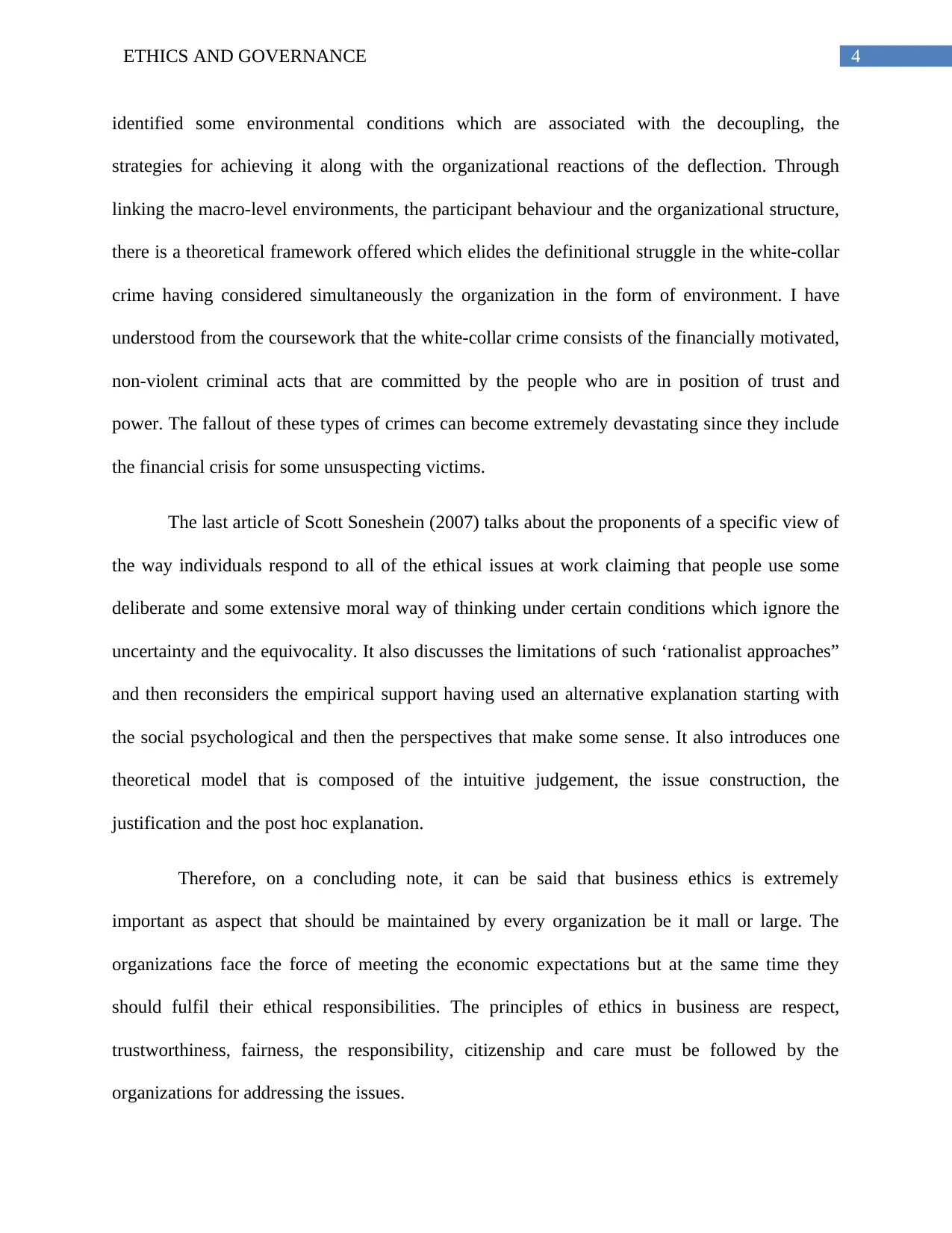
4ETHICS AND GOVERNANCE
identified some environmental conditions which are associated with the decoupling, the
strategies for achieving it along with the organizational reactions of the deflection. Through
linking the macro-level environments, the participant behaviour and the organizational structure,
there is a theoretical framework offered which elides the definitional struggle in the white-collar
crime having considered simultaneously the organization in the form of environment. I have
understood from the coursework that the white-collar crime consists of the financially motivated,
non-violent criminal acts that are committed by the people who are in position of trust and
power. The fallout of these types of crimes can become extremely devastating since they include
the financial crisis for some unsuspecting victims.
The last article of Scott Soneshein (2007) talks about the proponents of a specific view of
the way individuals respond to all of the ethical issues at work claiming that people use some
deliberate and some extensive moral way of thinking under certain conditions which ignore the
uncertainty and the equivocality. It also discusses the limitations of such ‘rationalist approaches”
and then reconsiders the empirical support having used an alternative explanation starting with
the social psychological and then the perspectives that make some sense. It also introduces one
theoretical model that is composed of the intuitive judgement, the issue construction, the
justification and the post hoc explanation.
Therefore, on a concluding note, it can be said that business ethics is extremely
important as aspect that should be maintained by every organization be it mall or large. The
organizations face the force of meeting the economic expectations but at the same time they
should fulfil their ethical responsibilities. The principles of ethics in business are respect,
trustworthiness, fairness, the responsibility, citizenship and care must be followed by the
organizations for addressing the issues.
identified some environmental conditions which are associated with the decoupling, the
strategies for achieving it along with the organizational reactions of the deflection. Through
linking the macro-level environments, the participant behaviour and the organizational structure,
there is a theoretical framework offered which elides the definitional struggle in the white-collar
crime having considered simultaneously the organization in the form of environment. I have
understood from the coursework that the white-collar crime consists of the financially motivated,
non-violent criminal acts that are committed by the people who are in position of trust and
power. The fallout of these types of crimes can become extremely devastating since they include
the financial crisis for some unsuspecting victims.
The last article of Scott Soneshein (2007) talks about the proponents of a specific view of
the way individuals respond to all of the ethical issues at work claiming that people use some
deliberate and some extensive moral way of thinking under certain conditions which ignore the
uncertainty and the equivocality. It also discusses the limitations of such ‘rationalist approaches”
and then reconsiders the empirical support having used an alternative explanation starting with
the social psychological and then the perspectives that make some sense. It also introduces one
theoretical model that is composed of the intuitive judgement, the issue construction, the
justification and the post hoc explanation.
Therefore, on a concluding note, it can be said that business ethics is extremely
important as aspect that should be maintained by every organization be it mall or large. The
organizations face the force of meeting the economic expectations but at the same time they
should fulfil their ethical responsibilities. The principles of ethics in business are respect,
trustworthiness, fairness, the responsibility, citizenship and care must be followed by the
organizations for addressing the issues.
Paraphrase This Document
Need a fresh take? Get an instant paraphrase of this document with our AI Paraphraser
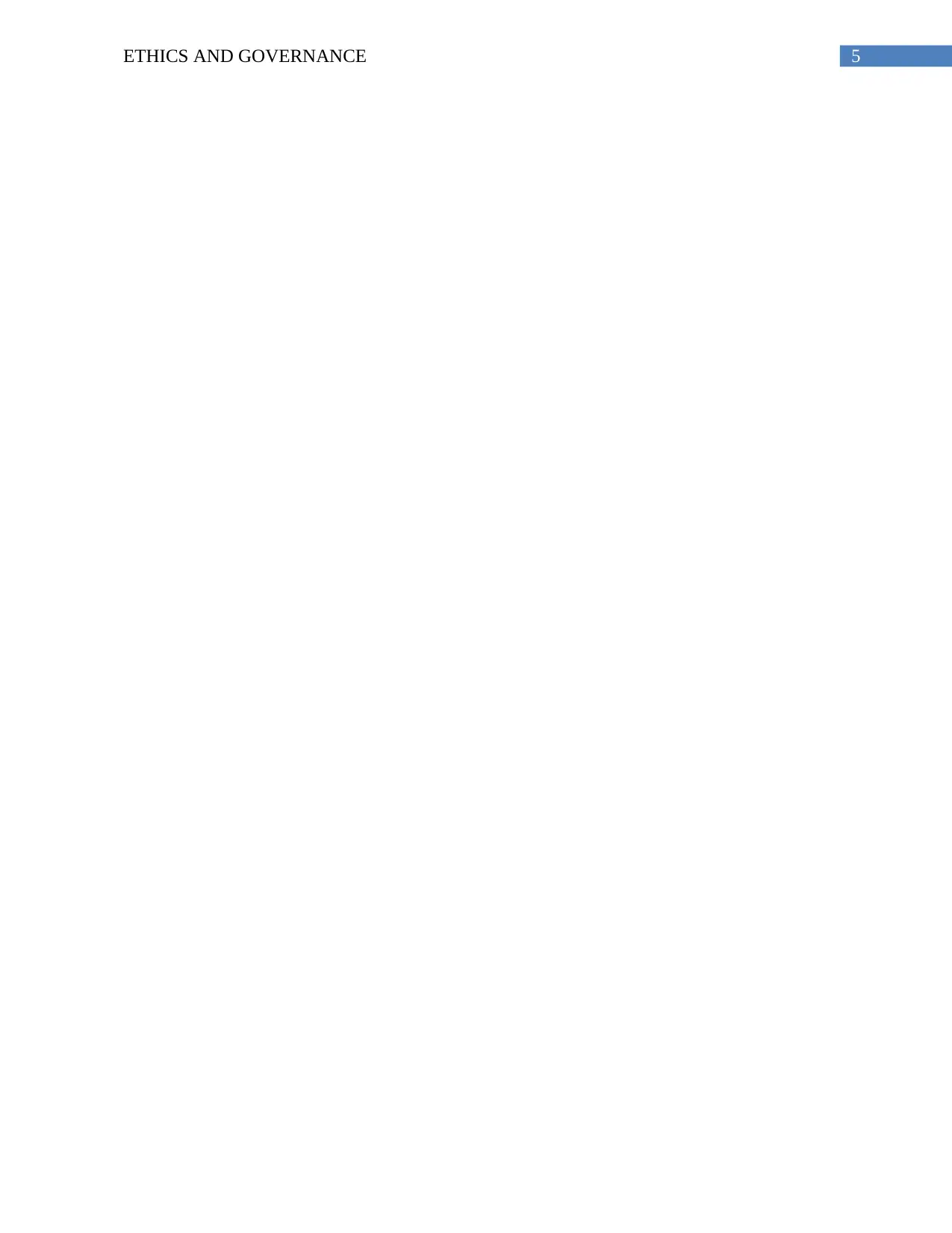
5ETHICS AND GOVERNANCE
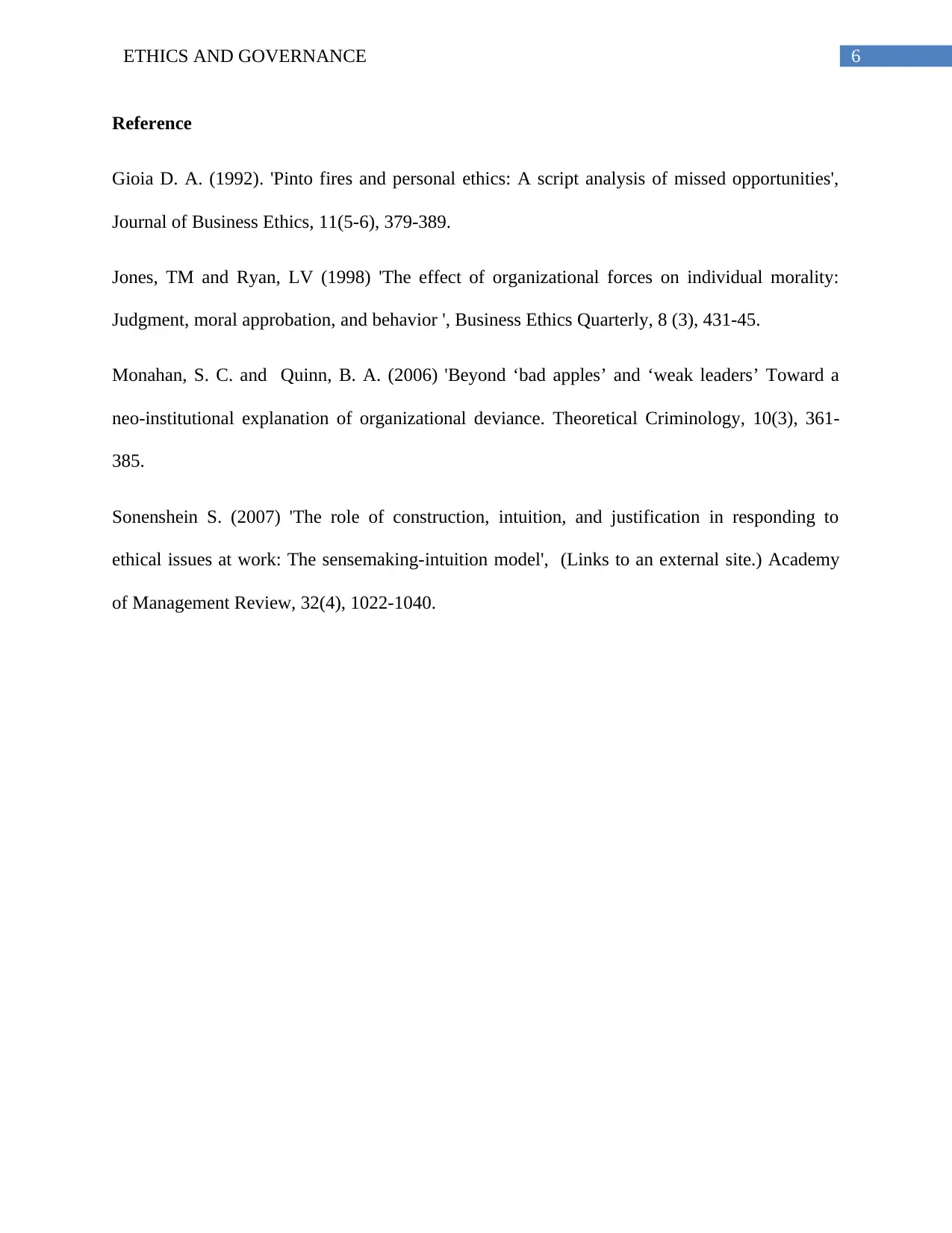
6ETHICS AND GOVERNANCE
Reference
Gioia D. A. (1992). 'Pinto fires and personal ethics: A script analysis of missed opportunities',
Journal of Business Ethics, 11(5-6), 379-389.
Jones, TM and Ryan, LV (1998) 'The effect of organizational forces on individual morality:
Judgment, moral approbation, and behavior ', Business Ethics Quarterly, 8 (3), 431-45.
Monahan, S. C. and Quinn, B. A. (2006) 'Beyond ‘bad apples’ and ‘weak leaders’ Toward a
neo-institutional explanation of organizational deviance. Theoretical Criminology, 10(3), 361-
385.
Sonenshein S. (2007) 'The role of construction, intuition, and justification in responding to
ethical issues at work: The sensemaking-intuition model', (Links to an external site.) Academy
of Management Review, 32(4), 1022-1040.
Reference
Gioia D. A. (1992). 'Pinto fires and personal ethics: A script analysis of missed opportunities',
Journal of Business Ethics, 11(5-6), 379-389.
Jones, TM and Ryan, LV (1998) 'The effect of organizational forces on individual morality:
Judgment, moral approbation, and behavior ', Business Ethics Quarterly, 8 (3), 431-45.
Monahan, S. C. and Quinn, B. A. (2006) 'Beyond ‘bad apples’ and ‘weak leaders’ Toward a
neo-institutional explanation of organizational deviance. Theoretical Criminology, 10(3), 361-
385.
Sonenshein S. (2007) 'The role of construction, intuition, and justification in responding to
ethical issues at work: The sensemaking-intuition model', (Links to an external site.) Academy
of Management Review, 32(4), 1022-1040.
⊘ This is a preview!⊘
Do you want full access?
Subscribe today to unlock all pages.

Trusted by 1+ million students worldwide
1 out of 6
Related Documents
Your All-in-One AI-Powered Toolkit for Academic Success.
+13062052269
info@desklib.com
Available 24*7 on WhatsApp / Email
![[object Object]](/_next/static/media/star-bottom.7253800d.svg)
Unlock your academic potential
Copyright © 2020–2025 A2Z Services. All Rights Reserved. Developed and managed by ZUCOL.





